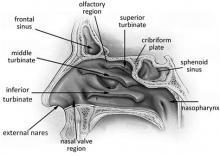Roundup: Pathogenesis and Prognosis of CRSwNP, CRSsNP, and AERD
B Cells and Antibodies in the Pathogenesis of CRSwNP and AERD1
A recent review of published literature on B cells and antibodies outlines their possible role in the disease pathogenesis of chronic rhinosinusitis with nasal polyps (CRSwNP). Evidence supports that the pathogenesis of CRSwNP and aspirin-exacerbated respiratory disease (AERD) relies on local activation of B cells and antibody production.
The development of tertiary lymphoid structures is an important part of local activation of B cells and antibody production, which is crucial for fighting infections. Adversely, it plays a part in autoimmune disease and many allergic diseases. Elevated levels of activated B-cell subsets and antibodies produced in the nasal passage can be found in nasal polyp tissues from patients with CRSwNP and AERD. The antibodies may assist in disease pathogenesis through multiple mechanisms, such as activation of innate effector cells. Locally activated B cells assist in pathogenesis by activating T cells.
“More studies are needed to determine the role of B cells and antibodies in driving disease in these patients,” the researchers concluded. “However, targeting the processes that drive local B cell activation and antibody production may provide new therapeutic approaches and could help to reduce chronic inflammation.”
Epithelial Squamous Metaplasia and Dysplasia in Nasal Polyps2
Researchers evaluated the existence of epithelial squamous metaplasia and dysplasia in nasal polyps located in the ethmoid sinuses.
They analyzed medical records from 212 patients with nasal polyps who had undergone an endoscopic ethmoidectomy. Patients who were histopathologically determined to have epithelial atypia were compared with patients with “normal” nasal polyps. Patient characteristics were also evaluated, including gender, age, smoking status, aspirin sensitivity, and occupational exposure, among other characteristics, to determine the potential etiological factors that contributed to epithelial atypia.
“Our results suggest epithelial atypia in [nasal polyps] are associated with aspirin sensitivity and occupational exposure to different noxious chemicals. Although extremely rare, epithelial dysplasia may occasionally be noted in [nasal polyps], a fact potentially useful for both rhinologists and pathologists,” the researchers concluded.
Nasal Bacterial Microbiome, Pathogenesis, and Prognosis of CRSwNP3
Researchers examined the role of the nasal bacterial microbiome on the pathogenesis and prognosis of patients with chronic rhinosinusitis with nasal polyps (CRSwNP).
Secretions from the nasal meatus of 77 patients with CRSwNP, 36 patients with chronic rhinosinusitis without nasal polyps (CRSsNP), and 34 patients in a control population were sampled. After detecting the bacterial microbiome composition in each of the 3 groups, the researchers compared the distinctions in the nasal microbial diversity. Nasal polyp tissues were also collected to analyze the expression of interleukin 5 and to study the relationship with the characteristics of the microbiome in the paranasal sinuses.
The researchers conducted postoperative follow-ups with patients with CRSwNP for 1 year. They found an association between microbial dysbiosis in the nasal cavity and the pathogenesis of CRSwNP.
“The recurrence of nasal polyps after [endoscopic sinus surgery] may be potentially related to the decrease in protective bacteria and the increase in pathogenic bacteria, and the improvement of postoperative bacterial disorder is correlated with the nonrecurrence of CRSwNP,” the researchers concluded.
Neutrophilic Inflammation and Eosinophilic Type 2 Inflammatory CRSwNP4
An association has been identified between severe neutrophilic inflammation and severe eosinophilic type 2 inflammatory chronic rhinosinusitis with nasal polyps (CRSwNP).
Differing rates of neutrophilic and eosinophilic inflammation were found in patients with CRSwNP and chronic rhinosinusitis without nasal polyps (CRSsNP). There was substantial neutrophilic infiltration and activation in type 2 CRSwNP, which was linked to eosinophil extracellular traps cell death and Carcot-Leyden crystals. It was not associated with interleukin 17.
“Neutrophil extracellular traps cell death in CRSwNP was associated with bacterial colonization, however, neutrophils were less prone to undergo neutrophil extracellular traps cell death in the tissue of patients with severe type 2 CRSwNP. Neutrophils did not show increased migration nor survival in the CRSwNP environment in vitro,” the researchers of the study concluded.
Mechanisms, Biomarkers, and Inflammatory Endotypes in CRSsNP5
Researchers aimed to target mechanisms and biomarkers associated with the inflammatory endotypes supporting chronic rhinosinusitis without nasal polyps (CRSsNP) by analyzing ethmoid tissues and nasal lavage fluids from patients with chronic rhinosinusitis and from patients in a control group.
Microarray analysis and quantitative reverse transcription polymerase chain reaction tests were used to determine the gene expression profiles. ELISA and Luminex analyses were used to measure protein expression.
“Inflammatory endotypes in CRSsNP were controlled by different molecular mechanisms,” the researchers concluded. “[Nasal lavage fluid] biomarker assays may allow for more precise and personalized medical treatments in chronic rhinosinusitis.”
—Jessica Bard
References:
- Buchheit KM, Hulse KE. Local immunoglobulin production in nasal tissues: a key to pathogenesis in chronic rhinosinusitis with nasal polyps and aspirin-exacerbated respiratory disease. Ann Allergy Asthma Immunol. 2021;126(2):127-134. https://doi.org/10.1016/j.anai.2020.09.016
- Perić A, Stoiljkov M, Đokić D, Đurđević BV. Epithelial squamous metaplasia and dysplasia in inflammatory nasal polyps: an observational study. Ear Nose Throat J. 2021;100(2):NP120-NP124. https://doi.org/10.1177/0145561319862207
- Gan W, Zhang H, Yang F, Liu S, Liu F, Meng J. The influence of nasal bacterial microbiome diversity on the pathogenesis and prognosis of chronic rhinosinusitis patients with polyps. Eur Arch Otorhinolaryngol. 2021;278(4):1075-1088. https://doi.org/10.1007/s00405-020-06370-4
- Delemarre T, Holtappels G, De Ruyck N, et al. A substantial neutrophilic inflammation as regular part of severe type 2 chronic rhinosinusitis with nasal polyps. J Allergy Clin Immunol. 2021;147(1):179-188.e2. https://doi.org/10.1016/j.jaci.2020.08.036
- Klingler AI, Stevens WW, Tan BK, et al. Mechanisms and biomarkers of inflammatory endotypes in chronic rhinosinusitis without nasal polyps. J Allergy Clin Immunol. 2021;147(4):1306-1317. https://doi.org/10.1016/j.jaci.2020.11.037



